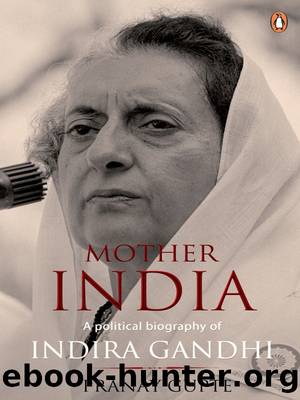Mother India by Pranay Gupte

Author:Pranay Gupte [Pranay Gupte]
Language: eng
Format: epub
ISBN: 9788184755480
Publisher: Penguin Books India Pvt Ltd.
Published: 2012-02-02T18:30:00+00:00
PART IV
TRIUMPH AND TWILIGHT
15. Taking on Titans
IN THE BATTLE to ensure Zakir Husainâs nomination for President, Indira Gandhi had shown that she could marshal key votes within the organizational structure of the Congress on issues that mattered to her. Muslims were pleased with Zakir Husainâs election to the presidency; Indira received encomiums from the world media as well for supporting so determinedlyâand skilfullyâa man from a minority community for Indiaâs highest public office.
During this period, Indira was also beginning to establish a modus vivendi with Morarji Desai, who still did not like her much but who had started to curtail his criticismsâno doubt in the worthy cause of self-interest. Desai even supported her choice of Husain. More than the Congress Party bosses, Desai understood the arithmetic of the presidential electionâthat Indiraâs choice would be supported by the Communists and independent legislators. In other words, once Indira had resolved that Zakir Husain would be Indiaâs next President, she went all out to campaign for him, creating an irreversible momentum in his favour.
The truce between Indira and Desai turned out to be temporary. It began unravelling over the question of relations between the Central government and state governments. That question was to assume even greater significance during the latter part of Indiraâs career as prime minister. Morarji Desai now started telling associates that he felt Indira was not âstern enoughâ in dealing with ministries in various states that were controlled by Opposition parties. In particular, Desaiâwhose own politics were definitely right of centreâfelt that Indira was being excessively tolerant of Communist leaders in West Bengal and Kerala. He knew how hard Indira had worked in the late 1950s, when she was Congress president, to topple the Communist government in Kerala. And now the same Indira suddenly seemed quite willing to live and let live. Krishan Bhatia writes: âWhat shaped her attitude toward the non-Congress state governments was the conviction that in a federal system of government, the center must learn to live with states ruled by rival parties. Like Desai, she would have preferred to have her own party rule all the states, but she did not feel inclined to embark on a vendetta against those who had succeeded in defeating the Congress by legitimate, constitutional means. While she saw the wisdom at that stage in avoiding confrontation with the non-Congress state governmentsâif she could get along with them by giving them a long ropeâDesai, still an unbending disciplinarian, saw in that stance unpardonable weakness and a vindication of his original claim that she was unfit to be the leader.â1
Indira knew full well that the Indian constitution provided for a federal system with certain unitary features and also a formal bias in favour of the Central government. But she also knew that in a vast country such as India, whose states were primarily predicated on linguistic divisions, regional forces had to be given adequate play. Since the reorganization of Indiaâs states along linguistic lines in 1956, there had been a gradual devolution of power to the states.
Download
This site does not store any files on its server. We only index and link to content provided by other sites. Please contact the content providers to delete copyright contents if any and email us, we'll remove relevant links or contents immediately.
Fanny Burney by Claire Harman(26254)
Empire of the Sikhs by Patwant Singh(22775)
Out of India by Michael Foss(16695)
Leonardo da Vinci by Walter Isaacson(12815)
Small Great Things by Jodi Picoult(6693)
The Six Wives Of Henry VIII (WOMEN IN HISTORY) by Fraser Antonia(5242)
The Wind in My Hair by Masih Alinejad(4852)
The Crown by Robert Lacey(4578)
The Lonely City by Olivia Laing(4577)
A Higher Loyalty: Truth, Lies, and Leadership by James Comey(4565)
The Iron Duke by The Iron Duke(4126)
Millionaire: The Philanderer, Gambler, and Duelist Who Invented Modern Finance by Janet Gleeson(4116)
Papillon (English) by Henri Charrière(3923)
Sticky Fingers by Joe Hagan(3916)
Joan of Arc by Mary Gordon(3797)
Alive: The Story of the Andes Survivors by Piers Paul Read(3743)
Stalin by Stephen Kotkin(3731)
Aleister Crowley: The Biography by Tobias Churton(3435)
Ants Among Elephants by Sujatha Gidla(3282)
